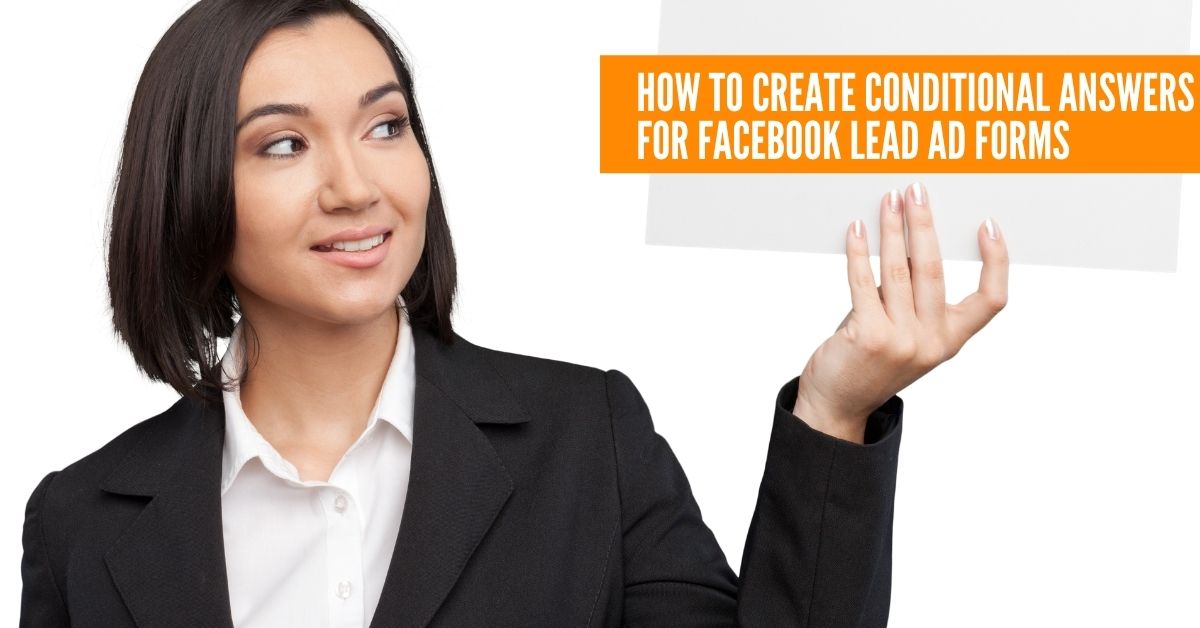Are you actively trying to grow your email list?
Facebook lead ads are an excellent tool to accumulate individuals’ email addresses. If this is your first Facebook Lead Ad, you should check out How to Create Your First Facebook Lead Ad Campaign. Lead ad forms are amplified with a conditional answers feature.
What is a conditional questions?
Conditional questions permit managers to ask a series of questions that can produce various response options based on the answers from the previous questions. When implementing conditional answers, always use the same questions, no matter the responses given. Although the questions remain the same, the answers are altered in response to the answers for the prior questions.
How do I set up conditional questions in Facebook Lead Ads?
When creating a Facebook Lead Ad form:
Ask for general information (i.e. name, email address, phone number)
Then, you will also have the option to create custom questions for specific information. You can choose how you want your audience to answer
Short Answer
Multiple Choice
Conditional
Choose conditional → then Facebook will ask you to upload a CSV file
In the CSV file : only include potential answers
Organize your answers into columns for each possible answer for every question
Example — If Question #1 is “Would you like a hat or a belt?” Then your answer options would be hat or belt
If Question #2 is “What color would you like?” Then your answer options are dependent on your answer to Question #1 (i.e. If the answer is hat, then it would be red or blue)
Add the answers to your CSV file and then upload
Then you can input your questions
If you need help downloading your leads from Facebook, you can find out more through this link click here.
Mastering Facebook Lead Form Conditional Questions for Effective Leads
Setting Up Conditional Questions
Use conditional logic to create dynamic forms that change based on user answers in real-time.
Set up conditional questions by uploading a CSV file with possible answers.
Map out the questions and answer options before creating the CSV file.
Use multiple choice questions to add conditional logic and filter leads.
Use short answer questions to get leads to provide additional information.
Using Instant Forms to Improve Lead Quality
Use instant forms to direct non-leads to close the form.
Only the people who answer the conditional question with a response determined to be a lead can submit the form.
Use conditional logic in instant forms to qualify leads by asking specific questions.
Instant forms can help you collect important information and filter out unqualified leads.
Mapping Conditional Questions to Marketo Fields
Facebook Lead Ads are designed to generate leads through simple forms, which may not allow for conditional visibility rules based on field answers.
Marketo forms are typically used for more detailed information gathering, and Facebook Lead Ads send leads in through an API connection.
To achieve conditional visibility rules, consider using a landing page with a more detailed form for further information gathering.
This approach allows for a more qualified lead generation process, with email follow-ups directing users to the landing page.
Best Practices for Conditional Questions in Lead Ads
Use conditional answers to ask follow-up questions based on user answers.
Use custom questions, including short answer, multiple choice, and conditional answers, to collect specific information from users.
Use conditional logic to direct leads to see a new or existing question.
Use appointment request questions to let leads request a meeting with you.
Common Use Cases for Conditional Questions
Use conditional questions to qualify leads based on their experience level with ads.
Use conditional questions to ask about how leads use Facebook ads.
Use conditional questions to collect specific information from users, such as locations leads prefer.
Use conditional questions to direct leads to submit the form or provide additional information.
Measuring and Optimizing Conditional Question Performance
Use analytics to track the performance of your conditional questions.
Test different conditional logic scenarios to optimize lead quality.
Use A/B testing to compare the performance of different conditional questions.
Monitor lead conversion rates to optimize your conditional question strategy.
Advanced Strategies for Effective Lead Generation
Use conditional logic to create a custom end page with a call to action.
Use conditional logic to provide a website URL or phone number to direct leads to your business.
Use conditional logic to create a confirmation message text field to thank leads for submitting the form.
Use at least one logic rule to ensure that leads meet specific criteria before submitting the form.

